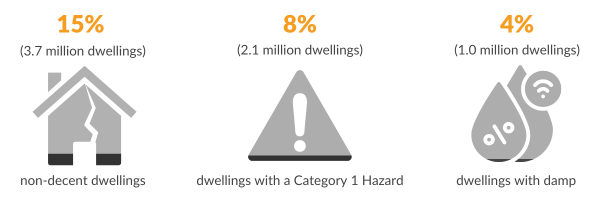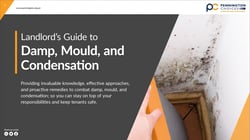Sign up to our newsletter
What is the HHSRS?
The Housing Health and Safety Rating System (HHSRS) is a risk-based evaluation tool designed to help local authorities identify hazards that pose a risk to the health and safety of tenants. Implemented in April 2006 under the Housing Act 2004, this system applies to residential properties in England and Wales.
As a requirement of the Decent Homes Standard, a HHSRS assessment should be undertaken as part of a Stock Condition Survey. HHSRS inspections evaluate the risks in buildings against 29 predefined hazard profiles. Each hazard that deviates from what the guidance deems an average property for its age and type is assigned a score. This score is determined by weighing the probability of an event leading to harm requiring medical attention for a member of the vulnerable group against the spread of harm that may occur. This numerical score categorises the hazard into a band, A to J, with A being the highest risk. Bands that fall between A-C are classed as a category 1 hazards; all other bands are category 2 hazards. Immediate action is required for category 1 hazards, whilst category 2 hazards only need to be addressed in certain situations.
To discover in-depth expert insight into the fundamentals of the HHSRS, watch our FREE on-demand webinar, ‘Housing Health and Safety Rating System (HHSRS) 101’, which highlights the HHSRS basics, the upcoming changes, and best practices developed from working with organisation on their HHSRS compliance.
What is the main aim of the HHSRS?
The HHSRS aims to provide a simple and consistent method for assessing risks posed by hazards in a property. The Housing Act 2004 provides the local authority with the enforcement powers to ensure hazards identified using the HHSRS assessment are promptly addressed, ultimately protecting the health and safety of tenants. Environmental Health Officers (EHOs) undertake the inspection, with the power to issue notices, fines, and evacuation orders if severe health and safety hazards are left unaddressed.
In 2022, 8% of dwellings had a category 1 hazard that required action to be taken. In addition, as one of the most high-profile hazards under the HHSRS, 4% of dwellings had a problem with damp, an increase from pre-pandemic levels (3%) with private rented dwellings rising from 7% to 9% between 2019 and 2022.

Source: English Housing Survey 2022-2023
Following the tragic death of Awaab Ishak in December 2020, there has been an increased focus on the importance of addressing damp and mould hazards across the housing sector. On 5th March 2024, the consultation on Awaab’s Law concluded, with an update from the government on the next steps and results of this consultation still being awaited. What is clear, however, is that for the first time in the sector, there will be predefined timescales for dealing with hazards that fall under the HHSRS. Find out everything you need to know about Awaab’s Law in our dedicated blog, ‘Awaab’s Law: What to expect’.
 To discover more about managing damp and mould in your properties, download our free Landlord’s Guide to Damp, Mould and Condensation here.
To discover more about managing damp and mould in your properties, download our free Landlord’s Guide to Damp, Mould and Condensation here.
The review
Almost two decades on from its implementation, the Ministry of Housing, Communities and Local Government (MHCLG) launched a scoping review in 2018 to decide whether the HHSRS should be updated. The review concluded that updates were necessary to simplify the system, empower landlords and tenants to engage with the system, and ensure alignment with other legislative standards and systems.
In September 2023, the government published a summary report, committing to implement the following changes to improve the HHSRS:
- Some of the hazards assessed will be amalgamated into groups to reduce the total number from 29 to 21 to produce a simpler means of banding results.
- The government will publish baselines that can be used to make an initial assessment of whether a property contains serious hazards (for example, ‘stairs must be safe, secure, in sound condition, free of defects and projections, well maintained’).
- The government will publish new statutory operating and enforcement guidance, a comprehensive set of new case studies, and specific tailored guidance for all stakeholders.
- The government recommended amalgamating the ‘Fire’ hazard with ‘Explosions in Dwellings’ to ensure the risk of fire in tall buildings can be assessed effectively.
These updates will be introduced via new legislation once the government has concluded its review of the Decent Homes Standard, part two of which began in Spring 2022.
To discover more expert insight into the upcoming HHSRS review, catch up on our webinar, 'Preparing for Change: HHSRS, Damp, Mould, and Condensation', for the latest updates on what to expect.
Your next steps
To prepare for the changes coming into force, it is crucial that you understand and use the current HHSRS following the recommended guidance to minimise the risk level of hazards in your buildings.
To discover a comprehensive overview of the categories and inspection process of the HHSRS, download your free guide to the Housing Health and Safety Rating System here to find out everything you need to know to keep your buildings safe.
Lessons learnt from helping organisations comply with the HHSRS highlight the necessity of understanding the current guidelines, ensuring you are recording inspections correctly, and remedying the hazards efficiently. It is important to remember that even when you have category 2 hazards, EHOs can still enforce penalties and take action against you if you fail to comply.







